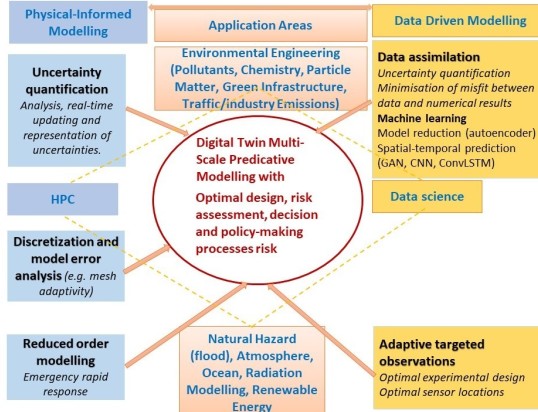Summary
My research areas focus on predictive modelling (machine learning, data assimilation methods, model reduction and optimal controls) in geophysical models as well as applications in ocean, atmospheric, multiphase flows and environmental problems. The application areas I mostly look at are environmental issues (air pollution), natural hazard (flooding, for example), ocean and engineering problems.

The application areas focus on:
- Machine learning based rapid response tools for real-time operation prediction, uncertain analysis and optimal controls;
- Sub-grid physical parameterization schemes in atmospheric modelling;
- Real time air pollution forecasting at high spatial and temporal scales;
- Machine learning-based coupling of multiple scale models from neighbour, city to street sales
- Real-time operational tools for urban environment (traffic, green infrastructure, land surface thermal dynamic modelling, radiation and indoor/outdoor);
- Natural hazard (e.g. flooding);
- Optimal monitoring sensor network;
- Renewable energy.
Biography
- 2002 – Present: Senior Research Fellow (2017-present), Research Fellow (2009-2017), PDRA (2002-2017), Earth Science and Engineering, Imperial College, London, UK.
- 2011 – 2014: Visiting Professor, Wuhan University, China.
- 2009-2010: Research Fellow/Scientist attached to both Imperial College London and the University of Karlsruhe, Germany
- 2000-2002: Postdoctoral Researcher, Laboratoire des Etudes Géophysiques et Océanographiques Spatiales, CNES/CNRS/OMP, Toulouse, France
- 1998-1999: Research Assistant, Department of Civil and Resource Engineering, the University of Auckland, New Zealand
- 1995-1998: PhD studies at James Cook University, Australia
- 1990-1995: Lecturer, North China Institute of Water Conservancy and Hydropower, Beijing
- 1984-1987: Engineering Assistant, China Institute of Water Resources and Hydropower Research, Beijing, China
Activitites
- Organiser of international workshops: Mathematics of the Weather, Germany , 2019; International Workshop of Applied Mathematics and Computation in the Atmosphere, China, 2018; Data assimilation section in Data Science & Machine Learning at International Workshop on Mathematics of Climate Change and Natural Disasters, Brazil, 2017.
- Invited talks at international conferences: e.g. Plenary Talk the Conference of Computational Interdisciplinary Science (CCIS 2019, USA); Invited talks at Mathematics of the Weather (MoW19, Germany); the international conference on Sustainable Development in Building and Environment and International Forum of Green Buildings and Healthy Buildings, SuDBE2019 UK; the Workshop of Applied Mathematics and Computation in the Atmosphere, 2018, China; ICCM2018, Italy; International Conference in the Mediterranean and the Middle East, Cyprus, 2018, etc.
- Review papers/proposals for ~10 international journals and research councils: RMetS, Environmental Modelling and Software, Building and Environment, Hydrology, Computer Methods in Applied Mechanics and Engineering, JCP, Scientific Report Nature, Water, Ocean Engineering etc.
- Member of American Geophysical Union, European Geophysical Union and SIAM
- In Marquis Who's who (2010), Active member, New York Academy of Sciences (2000).
Key publications
- D Xiao, F Fang, AG Buchan, CC Pain, IM Navon, J Du, G Hu. Non-linear model reduction for the Navier–Stokes equations using residual DEIM method, J. Comput. Phys., 263, 1-18, 2014. This paper presents a rapid numerical tool for real-time prediction and uncertainty quantification. The reduced order modelling (ROM) presented in this paper delivers substantial savings in computational cost, and has broad applicability (real time operational prediction, data assimilation, optimization controls, uncertainty sensitivities, etc). The novelty of the method lies in its treatment of the equation's non-linear operator, for which a new method is proposed that provides accurate simulations within an efficient framework. This is an essential step towards applying ROM to model complex realistic problems.
- D. Xiao, F. Fang*, J. Zheng, C.C. Pain, I.M. Navon, Machine learning-based rapid response tools for regional air pollution modelling, Atmospheric Environment, 199, 463-473, 2019 - This work provides a rapid response urban air pollution prediction and control tool based on machine learning. The rapid prediction tool has been successfully applied to a realistic case in China where the emissions from 100 power plants disperse through the atmosphere in time. The emission intensity at the power plant locations was obtained from the Regional Emission inventory in ASia data. In comparison to the high fidelity model, the CPU cost is reduced by factor up to five orders of magnitude while reasonable accuracy remains.
- Cheng, M., Fang, F*., Pain, C.C. and Navon, I.M., 2020. Data-driven modelling of nonlinear spatio-temporal fluid flows using a deep convolutional generative adversarial network. Computer Methods in Applied Mechanics and Engineering, 365, p.113000. – First DCGAN for detailed spatio-temporal distribution of nonlinear fluid flows.
- R. Hu, F. Fang*, P. Salinas, C.C. Pain, N.D. Sto. Domingo, O. Mark, Numerical simulation of floods from multiple sources using an adaptive anisotropic unstructured mesh method, Advanced in Water Resources, 123, 173-188, 2019. – First introduction of dynamically adaptive meshes to flooding.
- J. Zheng; F. Fang*, PhD; Z. Wang; J. Zhu; J. Li; J. Li; H. Xiao; C.C. Pain, 2020. A new anisotropic adaptive mesh photochemical model for ozone formation in power plant plumes, Atmospheric Environment, 229, 1352-2310. – First introduction of dynamically adaptive meshes to chemical modelling.
- F. Fang*, C. C. Pain, I.M. Navon, D. Xiao, An efficient goal based reduced order model approach for targeted adaptive observations, International Journal for Numerical Methods in Fluids, 83(3), 263-275, 2017. – First ROM-based targeted adaptive observation for optimising sensor locations.
- Z. Wang, D. Xiao, F. Fang, R. Govindan, C.C. Pain, Y. Guo, Model identification of reduced order fluid dynamics systems using deep learning, International Journal for Numerical Methods in Fluids, 86, 255-268, 2018. – First introduction of machine learning to reduced order modelling.
Selected Publications
Journal Articles
Cheng M, Fang F, Pain CC, et al., 2020, An advanced hybrid deep adversarial autoencoder for parameterized nonlinear fluid flow modelling, Computer Methods in Applied Mechanics and Engineering, Vol:372, ISSN:0045-7825, Pages:1-19
Cheng M, Fang F, Kinouchi T, et al., 2020, Long lead-time daily and monthly streamflow forecasting using machine learning methods, Journal of Hydrology, Vol:590, ISSN:0022-1694, Pages:1-13
Cheng M, Fang F, Pain CC, et al., 2020, Data -driven modelling of nonlinear spatio-temporal fluid flows using a deep convolutional generative adversarial network, Computer Methods in Applied Mechanics and Engineering, Vol:365, ISSN:0045-7825, Pages:1-18


